|
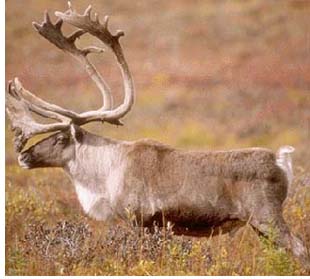 Although
the caribou Rangifer tarandus is one of Canada's most widely distributed
large mammals, most Canadians know it only as the animal on the 25-cent
piece. Caribou are most familiar to northern Canadians, for many of whom
they are an essential economic resource. The caribou's Micmac name was
"xalibu," meaning "the one who paws," and the present
name is probably a corruption of this word. Although
the caribou Rangifer tarandus is one of Canada's most widely distributed
large mammals, most Canadians know it only as the animal on the 25-cent
piece. Caribou are most familiar to northern Canadians, for many of whom
they are an essential economic resource. The caribou's Micmac name was
"xalibu," meaning "the one who paws," and the present
name is probably a corruption of this word.
Caribou
are found in Canada from the U.S.-Canada boundary in western Ontario and
British Columbia to northern Ellesmere Island, more than 4000 km north.
Their approximate range is shown on the accompanying map. Some caribou
are forest- and mountain-dwellers; some migrate each year between the
sparse forests and tundra of the far north; others remain on the tundra
all year.
Description
The caribou is
a medium-sized member of the deer family, Cervidae, which includes four
other species of deer native to Canada: moose, elk, white-tailed deer,
and mule deer. All are ungulates cloven- hoofed cud-chewers. However,
only in caribou do both males and most females carry antlers. Caribou
are similar to and belong tothe same species as the wild and domesticated
reindeer of Eurasia.
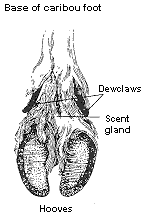 The
caribou is well adapted to its environment. It has a short, stocky body
and a long dense winter coat which provides effective insulation, even
during periods of low temperature and high wind. The muzzle and tail are
short and well haired. Large, concave hooves splay widely to support the
animal in snow or muskeg, and function as efficient scoops when the caribou
paws through snow to uncover lichens and other food plants. The sharp
edges give firm footing on ice or smooth rock. Caribou are excellent swimmers
and their hooves function well as paddles. In summer, the hooves are worn
away by travel over hard ground and rocks. The
caribou is well adapted to its environment. It has a short, stocky body
and a long dense winter coat which provides effective insulation, even
during periods of low temperature and high wind. The muzzle and tail are
short and well haired. Large, concave hooves splay widely to support the
animal in snow or muskeg, and function as efficient scoops when the caribou
paws through snow to uncover lichens and other food plants. The sharp
edges give firm footing on ice or smooth rock. Caribou are excellent swimmers
and their hooves function well as paddles. In summer, the hooves are worn
away by travel over hard ground and rocks.
A caribou bull (male) in full autumn pelage is an imposing animal with
its rich brown or grey and white pelage, dewlap fringe of white hair flowing
from throat to chest, and great rack of amber-coloured antlers. Adult
bulls generally shed their antlers in November or December, after they
have mated. Cows and young animals carry their antlers much longer, often
through the winter. The growing antlers have a fuzzy covering, called
velvet, which contains blood vessels carrying nutrients for growth.
The
ability of caribou to use lichens as a primary food distinguishes them
from all other large mammals and has enabled them to survive on harsh
northern rangeland. Caribou have an excellent sense of smell, which they
use to locate lichens under the snow.
Caribou
are very curious and hunters have found that by slowly waving their arms,
or bobbing up and down from the waist, they can often attract caribou
to close range.
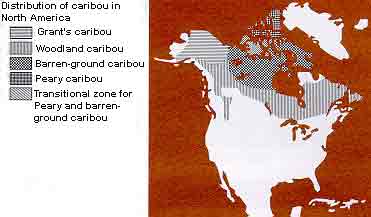 Races Races
There are three
types of caribou in Canada: woodland, barren-ground, and Peary. A fourth
type, the Queen Charlotte Island race, is extinct. The Queen Charlotte
Island caribou Rangifer tarandus dawsoni was a small, greyish caribou
found only on Graham Island. Little is known of this animal or of the
causes for its extinction, but deterioration of habitat due to climate
change was probably a more important cause than hunting.
The
Peary caribou Rangifer tarandus pearyi is a small, light-coloured caribou
found only in the islands of the Canadian arctic archipelago. Average
weights are 70 kg for bulls and 55 kg for cows. The total population was
estimated at 3300–3600 animals in the late 1980s and was declining.
Peary caribou are listed as threatened by the Committee on the Status
of Endangered Wildlife in Canada (COSEWIC) because of their low overall
numbers.
The
woodland caribou Rangifer tarandus caribou is a large, dark caribou that
is usually found in small herds in (boreal) forests from British Columbia
to Newfoundland. Average weights are 180 kg for bulls and 135 kg for cows.
In mountainous areas of western Canada, woodland caribou make seasonal
movements from winter range in forested valleys to summer range on high,
alpine tundra. Farther east, in the more level areas of boreal forest,
they may move only a few kilometres seasonally from mature forest to open
bogs. The George River Herd, however, is an exception to this pattern
and makes extensive seasonal movements between forested and tundra habitats
in Quebec and Labrador. This herd is currently estimated at over 500 000
animals and is the largest herd of caribou in Canada.
Woodland
caribou became extinct in Prince Edward Island before 1873 and in New
Brunswick and Nova Scotia by the 1920s. Today only a small, relic herd
on the Gaspé Peninsula remains of the maritime woodland caribou
population south and east of the St. Lawrence River. This herd is considered
threatened by COSEWIC. Caribou have also been severely reduced on the
southern edge of their distribution across the rest of Canada and exist
only in small, scattered herds from British Columbia to Quebec. The western
population of woodland caribou is categorized as vulnerable by COSEWIC.
Overhunting in some areas and changes in habitat in others brought about
the decline in numbers. Clearing of land for agriculture has destroyed
caribou habitat. Vast areas of forest have been logged or burned and replaced
by new growth that is much more suitable for moose and deer than for caribou.
The invading deer brought a neurological disease that kills caribou, although
it does not harm the deer. Opportunity for reintroduction of woodland
caribou to parts of its former range are therefore limited.
The
barren-ground caribou is somewhat smaller and lighter coloured than the
woodland caribou and spends much or all of the year on the tundra from
Alaska to Baffin Island. The Alaskan form, Grant's caribou Rangifer tarandus
granti, lives west of the Mackenzie River and the Canadian form Rangifer
tarandus groenlandicus lives to the east. Average weights for the smaller
Canadian form are 145 kg for bulls and 90 kg for cows. Most (about 1.2
million) of the barren-ground caribou in Canada live in five large herds,
which migrate seasonally from the tundra to the sparsely treed northern
coniferous forests, known as taiga. In order, from Alaska to Hudson Bay,
these are the Porcupine Herd, Bluenose Herd, Bathurst Herd, Beverly Herd,
and Kaminuriak Herd. Other barren-ground caribou (about 120 000) live
in smaller herds that spend the entire year on the tundra. Barren-ground
caribou make up the majority of caribou in Canada and are the mainstay
of many northern Amerindian and Inuit communities.
Annual
cycle of barren-ground caribou
The life of a
migratory barren-ground caribou has a fixed annual pattern. Most spend
winter in the taiga, but some always winter on the tundra. Usually the
bulls venture farthest south into the forest where snow tends to be deepest,
and the cows and juveniles remain nearer the tree line. The herds gather
in spring for the migration to the calving grounds and to their summer
range on the tundra.
Barren-ground
caribou are good navigators, unerringly walking hundreds of kilometres
in spring to their relatively small calving areas. They tend to follow
frozen lakes and rivers, open snow-free uplands, and eskers long narrow
hills of soil and rock dumped by glaciers to their destination. Caribou
are able to keep a steady direction across frozen lakes so large that
the opposite shore cannot be seen.
The
pregnant cows lead the spring migration, followed by the juveniles and
the bulls, which tend to lag farther and farther behind. Barren-ground
caribou cows head toward traditional calving grounds to which they return
year after year, even from different wintering areas. About 90 % of adult
cows (3 years old or older) produce calves annually. Most of the calves
are born in a 10-day period in late May or early June.
The
calves are well developed at birth and are able to travel within a few
hours. They start to graze during their first weeks, although at that
stage they can digest only milk. The cows and calves soon move to areas
where fresh-growing feed is becoming abundant. During summer they are
often harassed by hordes of mosquitoes, warble flies, caribou nostril
flies and, in some areas, black flies. Sometimes the agitated animals
will run for many kilometres, stopping to rest only when exhausted or
when high winds temporarily disperse the insects. Running from insects
places great energy demands on the caribou, and may retard their rate
of growth by temporarily reducing their foraging.
In
July the herds start to move en masse and feed on flowers, grasses, and
leaves of shrubs. The mating season, the rut, occurs in late October and
early November. By late September the herds, fat and in good condition
are arriving in pre-rutting areas. Bulls spar a great deal and sometimes
fight for possession of cows.
The
migration routes have always been so well established that, in past years,
Native hunters lay in wait for caribou at places where they would cross
lakes or rivers. Occasionally, however, the caribou did change their migration
routes, and hunters and their families located near the traditional migration
path faced starvation.
Enemies
The wolf is a
natural predator of the caribou. Wolf packs follow the migrating herds
from summer to winter range and back. Caribou are relatively free from
this predator only during calving time, when the breeding wolves are raising
their young in areas distant from the calving ground. A wolf requires
food equivalent to 11-14 caribou a year, and it may kill that many. Most
wolves also hunt mice, lemmings, other small mammals, and birds. Wolves
cannot run as fast for as long as healthy caribou, especially in deep
snow, so wolves often chase a caribou in relays, or wait in ambush for
an unwary victim.
Wolves
have a culling effect on the caribou population, as they kill the aged,
injured, or young weak animals when they are available. Most biologists
agree that the relationship between wolf and caribou benefits both. Certainly
the relationship has evolved and lasted over tens of thousands of years.
The
human being, however, is the greatest of all caribou predators. Many Canadian
Amerindians and Inuit based their culture on the caribou, and could not
have survived in the north without them. Some tribes were nomadic, and
followed the herds year round; others lived on caribou for part of the
year. Caribou provided food, clothing, and shelter: bones were made into
needles and utensils, antlers into tools, and the sinew into thread; the
fat provided fuel and light; the skin was made into light, warm clothing
and tent material; and the flesh fed people and dogs.
Conservation
The take by hunters
using primitive weapons was in balance with the numbers of caribou. The
introduction of the rifle by trappers and traders, however, made it possible
to kill large numbers. It is thought that in the three decades before
1950, kill by humans ranged from 100 000 to 200 000 a year. In some years,
this was more than the animals' natural increase.
Originally
there were probably at least three million barren-ground caribou. Their
numbers began to decline shortly after Europeans arrived in the North
armed with rifles and seeking furs. By 1949, when aerial survey methods
made it possible to count caribou for the first time, there were only
about 750 000 animals. Despite federal, territorial, and provincial government
attempts to reduce overhunting by supervising hunts and enforcing game
regulations, and in spite of an emergency wolf-control program, the population
continued to fall, to about 350 000 by 1955. For a time there was fear
that the caribou might, like the plains bison, approach extinction. However,
a 1967 range-wide survey by Canadian Wildlife Service biologists showed
that the decline had stopped. Barren-ground caribou now number about 1.3
million.
Exploration
and settlement of the north were possible because caribou provided food.
Today, caribou are still an economical source of meat because transporting
food into the north is expensive. The vast herds of migrating caribou
present a wildlife spectacle unequalled on this continent and, as an attraction
to naturalists, photographers, and sport hunters, could contribute to
a tourist industry in the north. Wisely used, caribou can be a continuing
economic resource in the North.
|

 Once
upon a time, in a camp near Great Slave Lake, there were no caribou
to kill. For days and days the families went without food. Everyone
was very hungry and weak.
Once
upon a time, in a camp near Great Slave Lake, there were no caribou
to kill. For days and days the families went without food. Everyone
was very hungry and weak. 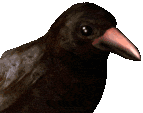 While
the people were talking, a man named Make-Bone said he would follow
the raven the next time he left their camp. So everyone returned
home, to wait for the raven to appear. The raven visited the camp
again the next day, not knowing about the plan the people had decided
upon. As usual, he entered each tent looking for a possible meal.
While
the people were talking, a man named Make-Bone said he would follow
the raven the next time he left their camp. So everyone returned
home, to wait for the raven to appear. The raven visited the camp
again the next day, not knowing about the plan the people had decided
upon. As usual, he entered each tent looking for a possible meal.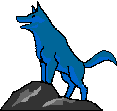 "I
can see him now," cried Make-Bone. "He's landing near a hill. Let's
follow him there!" Everyone started walking through the forest to
find the raven. It was a long walk and everyone became very tired.
Finally they arrived at the hill where Make-Bone had last seen the
raven.. At first they didn't see any sign of the bird. Then suddenly
they noticed a big spruce hut nearby. Quickly the people surrounded
the lodging. A wolf, who happened to appear then, offered to enter
the hut to see what was inside.
"I
can see him now," cried Make-Bone. "He's landing near a hill. Let's
follow him there!" Everyone started walking through the forest to
find the raven. It was a long walk and everyone became very tired.
Finally they arrived at the hill where Make-Bone had last seen the
raven.. At first they didn't see any sign of the bird. Then suddenly
they noticed a big spruce hut nearby. Quickly the people surrounded
the lodging. A wolf, who happened to appear then, offered to enter
the hut to see what was inside.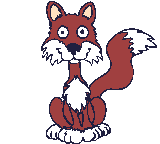 "Who
will enter the hut to spy on the raven?" the crowd asked. This time
a fox offered to help. Before he went in, he told the people to
put all the children on a pole rack, where they would be safe. Then
the fox told everyone to stand nearby. "Be ready to start spearing,"
he said. When the people were ready, the fox entered the hut. Once
inside, he brushed the fire with his bushy tail. This made large
clouds of smoke. Quickly he trotted outside with a trail of smoke
following him. Everyone waited patiently.
"Who
will enter the hut to spy on the raven?" the crowd asked. This time
a fox offered to help. Before he went in, he told the people to
put all the children on a pole rack, where they would be safe. Then
the fox told everyone to stand nearby. "Be ready to start spearing,"
he said. When the people were ready, the fox entered the hut. Once
inside, he brushed the fire with his bushy tail. This made large
clouds of smoke. Quickly he trotted outside with a trail of smoke
following him. Everyone waited patiently. Although
the caribou Rangifer tarandus is one of Canada's most widely distributed
large mammals, most Canadians know it only as the animal on the 25-cent
piece. Caribou are most familiar to northern Canadians, for many of whom
they are an essential economic resource. The caribou's Micmac name was
"xalibu," meaning "the one who paws," and the present
name is probably a corruption of this word.
Although
the caribou Rangifer tarandus is one of Canada's most widely distributed
large mammals, most Canadians know it only as the animal on the 25-cent
piece. Caribou are most familiar to northern Canadians, for many of whom
they are an essential economic resource. The caribou's Micmac name was
"xalibu," meaning "the one who paws," and the present
name is probably a corruption of this word. The
caribou is well adapted to its environment. It has a short, stocky body
and a long dense winter coat which provides effective insulation, even
during periods of low temperature and high wind. The muzzle and tail are
short and well haired. Large, concave hooves splay widely to support the
animal in snow or muskeg, and function as efficient scoops when the caribou
paws through snow to uncover lichens and other food plants. The sharp
edges give firm footing on ice or smooth rock. Caribou are excellent swimmers
and their hooves function well as paddles. In summer, the hooves are worn
away by travel over hard ground and rocks.
The
caribou is well adapted to its environment. It has a short, stocky body
and a long dense winter coat which provides effective insulation, even
during periods of low temperature and high wind. The muzzle and tail are
short and well haired. Large, concave hooves splay widely to support the
animal in snow or muskeg, and function as efficient scoops when the caribou
paws through snow to uncover lichens and other food plants. The sharp
edges give firm footing on ice or smooth rock. Caribou are excellent swimmers
and their hooves function well as paddles. In summer, the hooves are worn
away by travel over hard ground and rocks. Races
Races